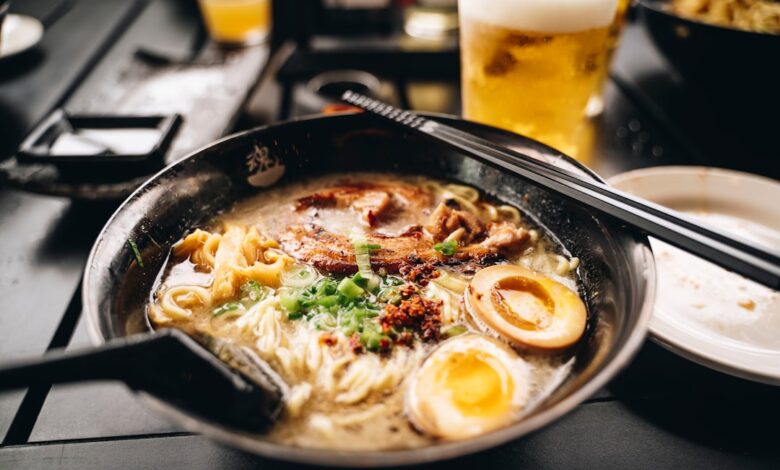Best Gluten Free Ramen

Craving a warm, comforting bowl of ramen but dealing with a gluten sensitivity or Celiac disease? Don’t worry, you don’t have to miss out! Finding delicious gluten-free ramen options used to be a challenge, but thankfully, there are now some fantastic choices available. As someone who has been navigating the gluten-free world for years, I’m here to guide you to the best gluten-free ramen out there.
What Makes Ramen “Ramen” Anyway?
Before diving into gluten-free options, let’s quickly cover what traditional ramen consists of. At its heart, ramen is a Japanese noodle soup. The key components are: wheat noodles, a flavorful broth (typically meat or fish-based), toppings like sliced pork (chashu), seaweed (nori), green onions, and a soft-boiled egg. The wheat noodles are what give ramen its characteristic chewy texture, but unfortunately, they also contain gluten.
The Gluten Challenge: Finding Suitable Noodles
The biggest hurdle in creating gluten-free ramen is replacing the wheat noodles. Thankfully, several alternatives work beautifully! Rice noodles are a popular choice, offering a similar texture and subtle flavor that allows the broth to shine. Shirataki noodles, made from konjac root, are another low-carb and gluten-free option. They have a slightly different texture – more slippery – but can still provide a satisfying ramen experience. Other gluten-free noodle options include those made from tapioca, sweet potato starch, or a blend of gluten-free flours.
Top Gluten-Free Ramen Brands and Options
Alright, let’s get to the good stuff! Here are some of my favorite gluten-free ramen brands and options, considering taste, texture, and overall experience:
- Lotus Foods Rice Ramen: While I said I wouldn’t use lists unless absolutely necessary, I find it necessary to list these particular brands! Lotus Foods offers certified gluten-free rice ramen noodles in various flavors like millet and brown rice. These are widely available and easy to prepare. They have a great texture and hold up well in broth.
- King Soba Organic Brown Rice Ramen: King Soba provides another reliable gluten-free ramen noodle option. Their brown rice ramen has a slightly nutty flavor that complements many broths.
- Immi Ramen: These are a newer option, but they’re gaining popularity for their focus on being both gluten-free *and* high in protein and fiber. They use a blend of pumpkin seed protein, wheat protein (modified to be gluten-free – read the label carefully if you’re highly sensitive), and other ingredients. These are more expensive, but the nutritional profile is appealing.
Keep in mind that even if the noodles are gluten-free, you *must* check the ingredients of the broth and any included seasoning packets. Many pre-packaged ramen broths contain soy sauce (which usually has wheat), or other gluten-containing ingredients. Look for broths made with tamari (a gluten-free soy sauce alternative), or better yet, make your own!
Crafting Your Perfect Gluten-Free Ramen Bowl: Broth is Key!
The broth is the soul of ramen. Since pre-made options can be tricky, making your own gluten-free broth gives you complete control. Here are a few ideas:
Chicken Broth: A classic and versatile choice. Use a high-quality chicken broth as a base, then enhance it with ginger, garlic, green onions, and a splash of tamari or coconut aminos for umami.
Vegetable Broth: For a vegetarian or vegan option, vegetable broth is fantastic. Roast your vegetables (onions, carrots, celery, mushrooms) before simmering them in water for a richer flavor. Season with kombu (dried kelp) for added depth.
Mushroom Broth: This broth is incredibly savory and flavorful. Use a combination of dried and fresh mushrooms (shiitake, cremini, oyster) for the best results. Simmer them with ginger, garlic, and a touch of soy sauce (tamari, of course!).
Topping It Off: Gluten-Free Ramen Perfection
Once you have your noodles and broth sorted, it’s time to add the toppings! This is where you can really customize your ramen and make it your own. Here are some gluten-free topping ideas:
Protein: Sliced pork (chashu) is traditional, but you can also use grilled chicken, shrimp, tofu, or a soft-boiled egg.
Vegetables: Green onions, bean sprouts, spinach, bamboo shoots, corn, and nori (dried seaweed) are all excellent choices.
Flavor Boosters: A drizzle of sesame oil, a sprinkle of sesame seeds, chili flakes, or a dollop of chili garlic sauce can add extra flavor and heat.
Don’t forget the egg! A soft boiled or marinated egg is a classic ramen topping that adds richness and flavor.
Safety First: Avoiding Cross-Contamination
If you have Celiac disease or a severe gluten sensitivity, it’s crucial to prevent cross-contamination. Use separate pots, pans, and utensils when preparing gluten-free ramen. Be especially careful with cutting boards, as they can harbor gluten even after washing. It’s also a good idea to inform restaurant staff about your dietary needs when ordering ramen out.
Gluten-Free Ramen: Benefits and Considerations
Embracing gluten-free ramen allows you to enjoy a comforting and satisfying meal without the digestive discomfort that gluten can cause. It can also be a great way to incorporate more vegetables and lean protein into your diet. However, it’s important to be mindful of the sodium content in ramen broths, both store-bought and homemade. Opt for low-sodium options or use less broth to control your sodium intake. Also be aware that gluten-free ramen may sometimes be lower in fiber than traditional wheat-based ramen, so be sure to include plenty of vegetables in your bowl.
Frequently Asked Questions
Is soy sauce gluten-free?
Traditional soy sauce is *not* gluten-free because it’s made with wheat. However, tamari is a gluten-free soy sauce alternative. Always check the label to confirm that it’s certified gluten-free.
Can I use regular chicken broth for gluten-free ramen?
It depends. Many store-bought chicken broths are gluten-free, but some may contain wheat-based thickeners or other gluten-containing ingredients. Read the ingredient list carefully or make your own chicken broth from scratch.
Where can I buy gluten-free ramen noodles?
Gluten-free ramen noodles are becoming increasingly available in grocery stores, health food stores, and online retailers. Look for brands like Lotus Foods, King Soba, and Explore Cuisine. Even some mainstream grocery stores now carry gluten-free options in their Asian foods sections.
Is it safe to eat ramen at a restaurant if I have Celiac disease?
It’s important to exercise caution when eating ramen at a restaurant if you have Celiac disease. Cross-contamination is a significant risk. Inquire about the ingredients of the noodles, broth, and toppings. Ask if they have separate preparation areas for gluten-free orders. If you’re unsure, it’s best to err on the side of caution and choose a different dish.
Gluten-free ramen doesn’t have to be a compromise. With the right ingredients and a little creativity, you can create a delicious and satisfying bowl that rivals the traditional version. Experiment with different noodles, broths, and toppings to find your perfect gluten-free ramen recipe. Happy slurping!
Related Posts
| Best Gluten Free Ramen Noodles |



